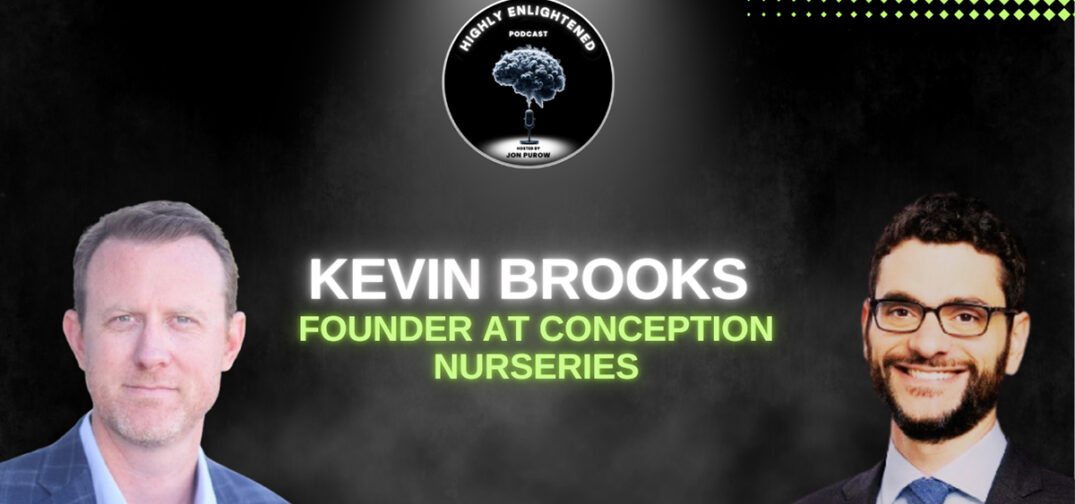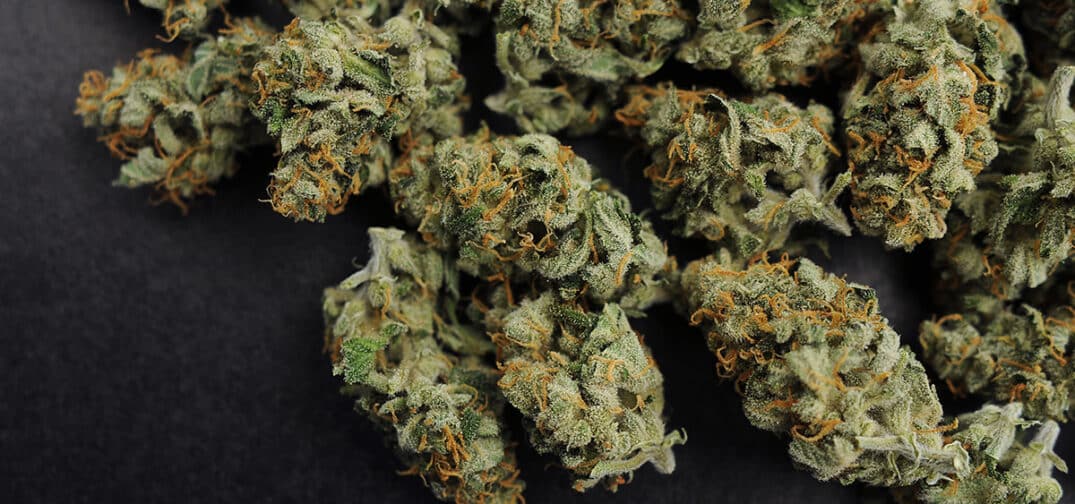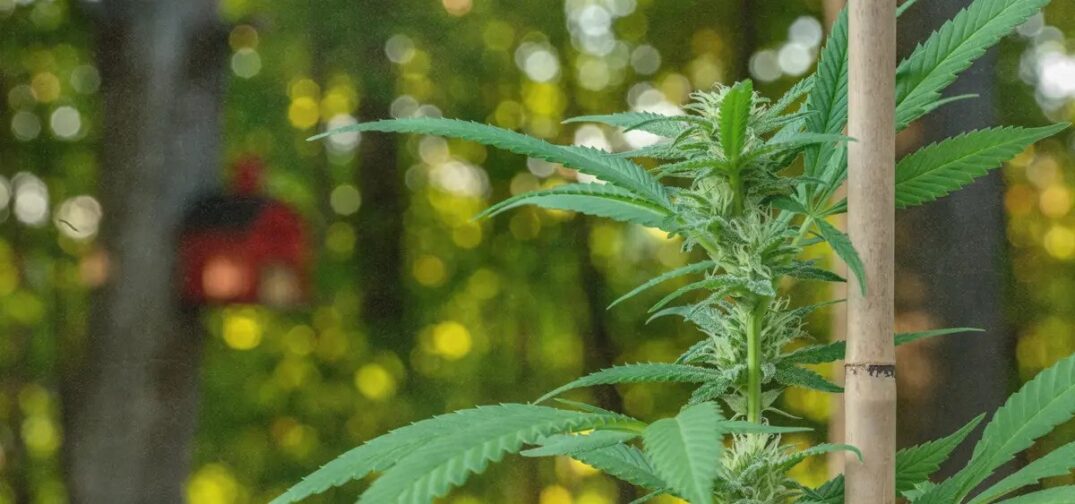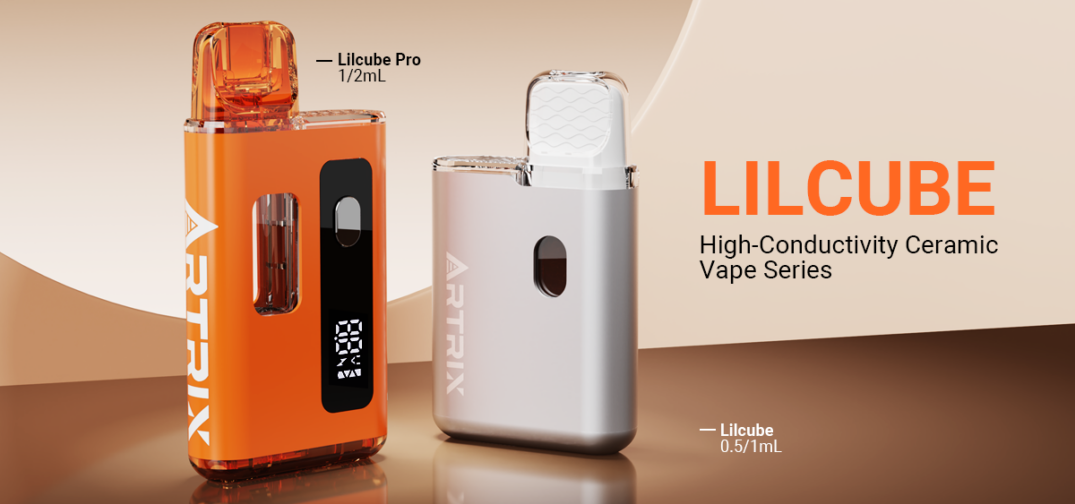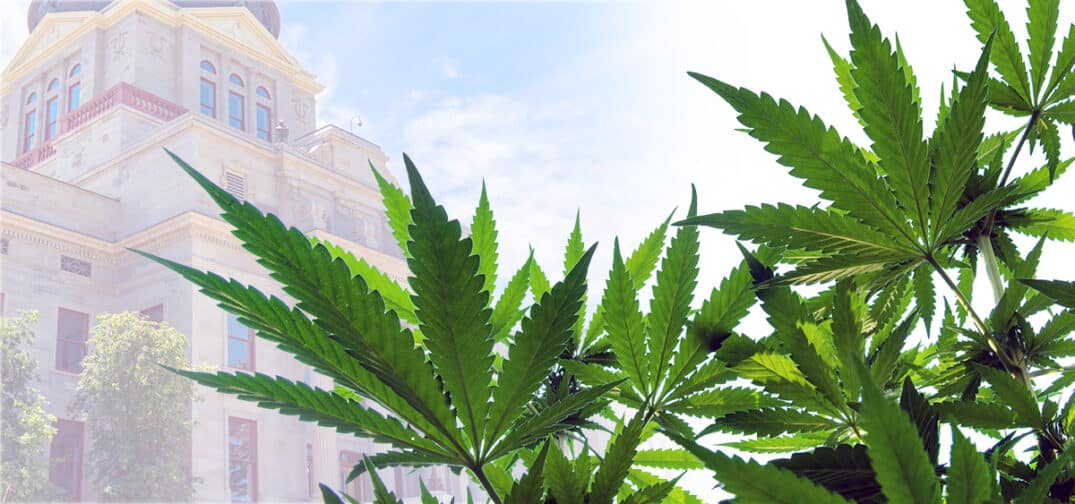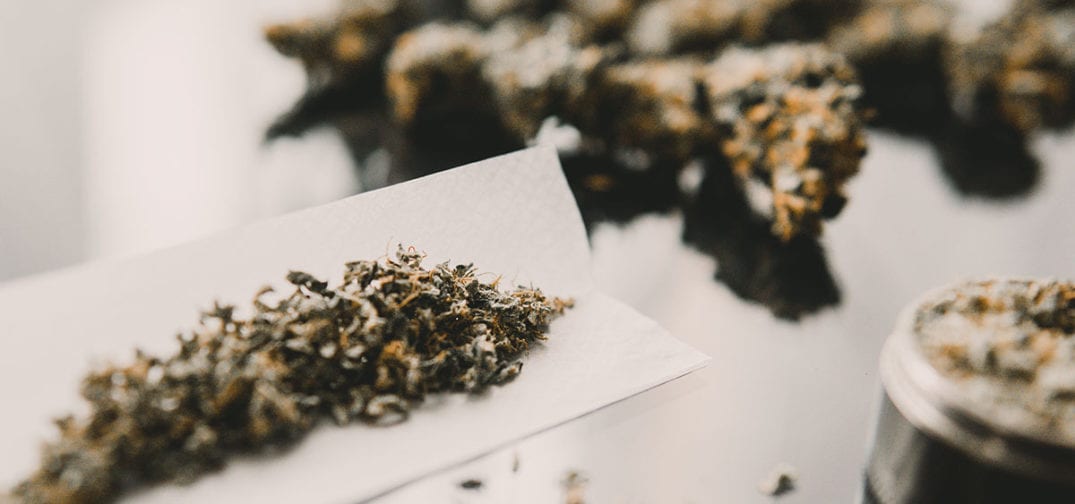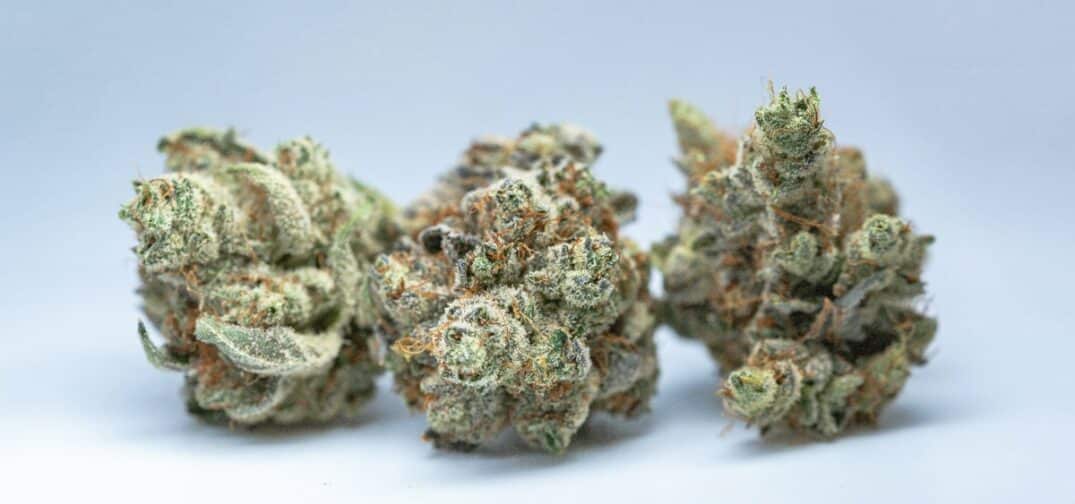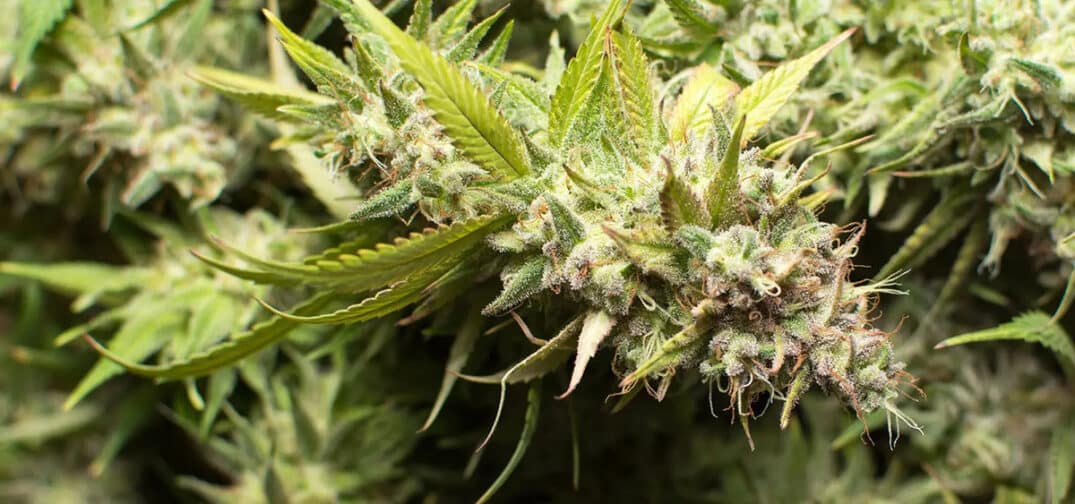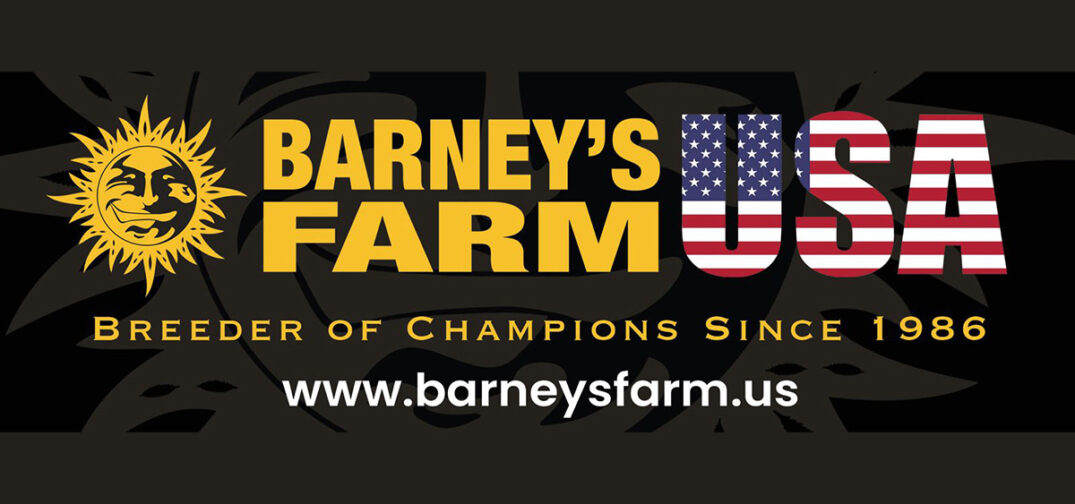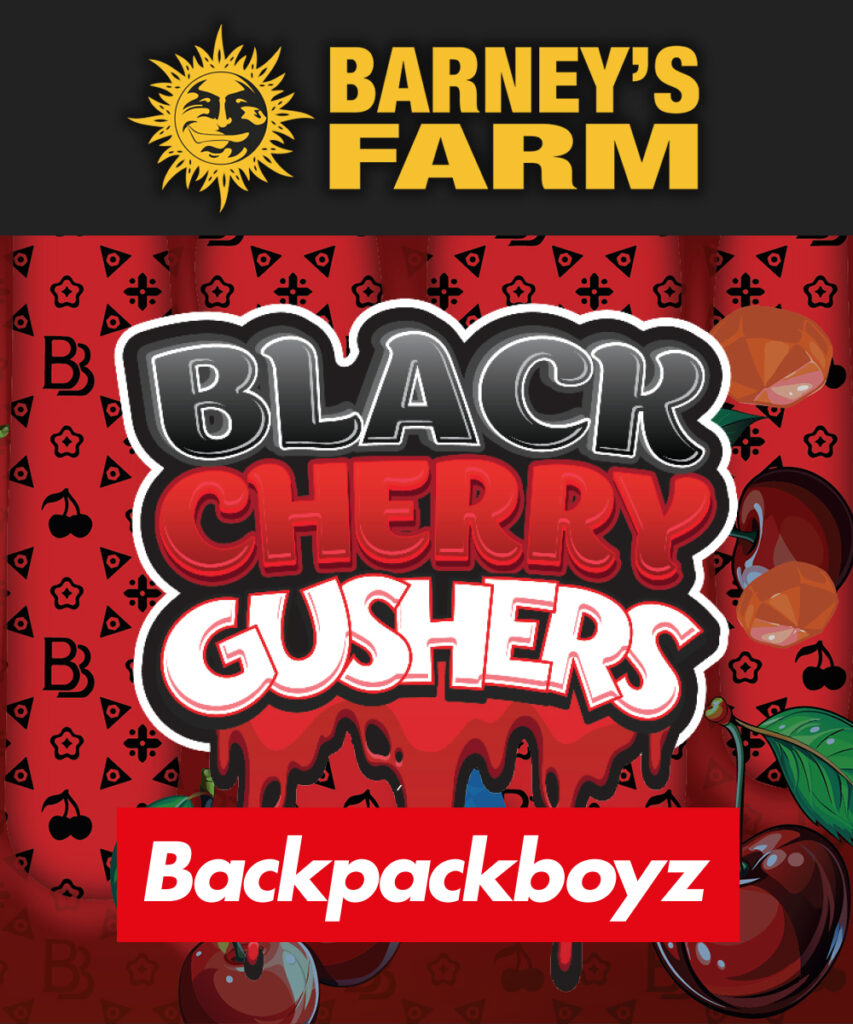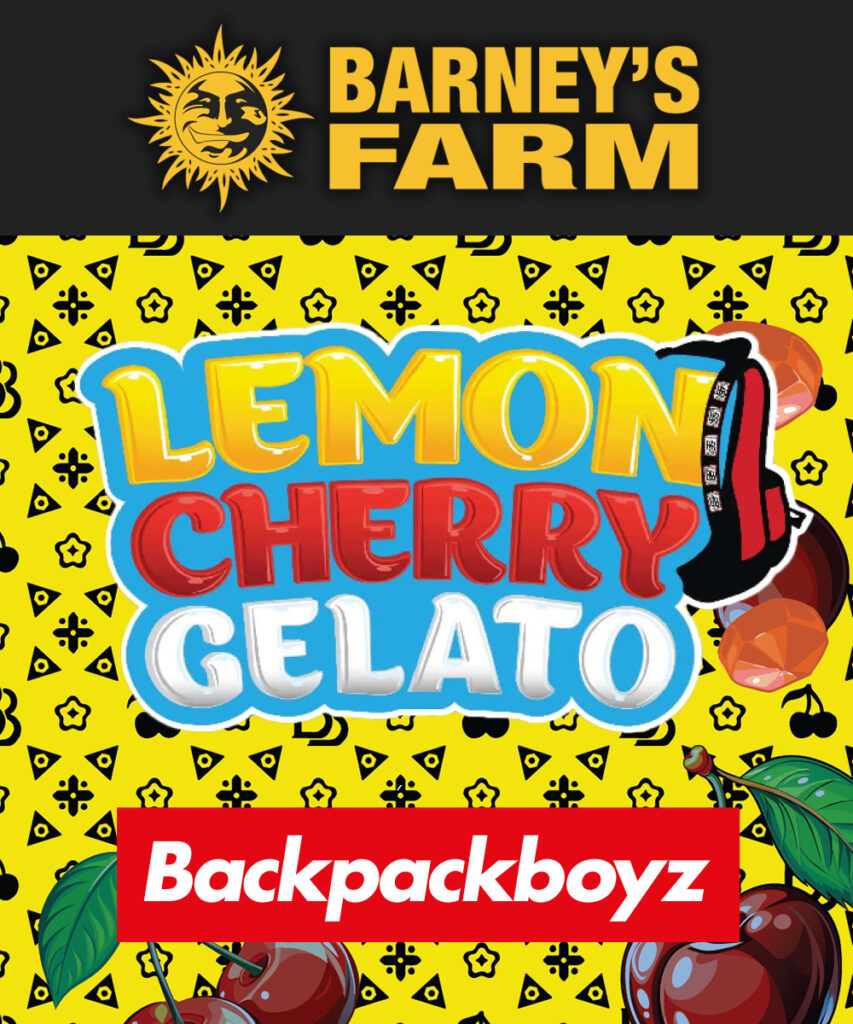Kevin Brooks, former CEO of Cookies Management and Connected Cannabis, identified plant health as a key vulnerability in the cannabis supply chain based on his experience leading vertically integrated cannabis operations in California. This insight led him to establish Conception Nurseries, a Sacramento-based company that provides commercial-scale tissue culture services to the cannabis industry. In addition to maintaining a large catalog of cultivar clones, Conception offers remediation, cold storage, and exclusive production services. Brooks brings prior leadership experience and successful exits from the regulated tech sector to his role at Conception. Listen or read the transcript below, and find more episodes of Highly Enlightened on Buzzsprout!
Listen to the episode:
Episode sponsored by eBottles:
This episode of Highly Enlightened is made possible by eBottles. If you’re in the cannabis business, you know that quality packaging isn’t just important—it’s essential. That’s where eBottles comes in. Whether you’re just starting out or scaling up, eBottles offers proprietary top-of-the-line packaging products built for cannabis. eBottles is a market leader for a good reason: they are experts in the field. Six patents, five warehouse locations around the country, a network of exceptional distributors. Get eBottles and Grow Boldly.
Read the transcript:
Editor’s note: this transcript was generated automatically and may contain errors.
Jon Purow:
Welcome to the Highly Enlightened Podcast, syndicated by Ganjapreneur. I’m your host, Jon Purow. So on this podcast we interview cannabis luminaries and I also cover Golden Nugget stories, which are stories that are not getting as much attention as they think they should. So tune in, join us, and as always, stay grassy. My buds. Alright, now with that, I have the pleasure of introducing Kevin Brooks, the CEO of conception nurseries. Kevin, I’m very, very excited to have you here so we could really kind of geek out about this stuff, but I just want, first, thank you for taking the time out of your busy schedule to come join me for this joint endeavor, pun always intended.
Kevin Brooks:
My pleasure. Yep, my pleasure. Thanks for having me. Glad to be here.
Jon Purow:
Yeah, yeah. So I like to talk a little bit, I mean, there are a few people who went directly into cannabis outside of the guests that I asked that question to the other day that made me look foolish. But there are a few people who started out in cannabis and I appreciate something we’re going to discuss with respect to your company, a comic book geek, and the origin stories were always called issue number zero. So my question to you, Kevin Brooks, is what from your issue, number zero, your origin story pre cannabis do you believe has been most useful in the cannabis industry?
Kevin Brooks:
Oh gosh, it’s a big question. Look, I think
Jon Purow:
The second question is what’s the meaning of life? So we just thought we’d start you easy. Okay.
Kevin Brooks:
Start easy. Yeah, A couple of softballs. Yeah. Look, I graduated college in 2002. We’re talking about right in the heart of the dot bomb. I’m in Silicon Valley. I get thrown into my first kind of recruiter sales job, and it was a fucking disaster, like recruiting software engineers during the dot bomb meltdown when layoffs were going left and I had buddies of mine that were answering the phone and making a ton of money. Then I get into the workforce and it was tough and it was really, really tough. And I think the one thing that I took away from my time in Silicon Valley, both in recruiting and then getting involved with my own company is really just resilience and grit. This is a really, really tough industry. Oftentimes, we’re working with both hands behind of our back. We’ve got unique regulatory challenges, we’ve got capital constraints, we’ve got interstate commerce challenges across the board. Imagine being a blueberry, launching a blueberry company and not being able to ship your product across state lines or get a bank account or receive funding. It’s just being able to pivot and read the tea leaves and just white knuckle it through tough times.
Jon Purow:
So I mean, to a certain extent I think that you’re kind of is that you can’t take no for an answer, right? Because in this industry you constantly face setbacks. Well, my prayer to the wifi gods might not have been answered. I am going to try the Scientology video chat. God von next. Maybe I’ll have more luck with that guy. Tom Cruise thinks so. Anyways, apologies for that. So basically the idea is that you don’t take no for an answer, right? Because I feel like even in this industry, no can be temporary. So here’s my follow up question. So we know that you face a setback, you’re not giving up first, you don’t succeed choke again. So if that’s the case with you, Kevin, then what skillset sets do you think that you and your team bring to the table in addressing issues like that that are most handy and help you get to the next step and grow as a company?
Kevin Brooks:
Yeah, I think it’s a much bigger answer, and I think the way that we kind of think about this business is it’s absolutely critical to have legacy cannabis folks who understand the culture, understand and are empathetic to growers’ challenges. But at the same time having smart business individuals who understand supply chain and operational consolidation and financial consolidation and being able to bridge those two, I guess two different philosophies. You look at some of the publicly traded companies that try to compete in the non-limited license states like California that are just getting their teeth kicked in. I mean, they’re just seen as very disingenuine. They don’t understand their consumer base. And then you have some of the private companies like for example, Elliot Lewis and Catalyst who is evangelical for his customer base, for his employees, for doing the right thing. He’s definitely out there, I love Elliot, but he has a workforce that lives and breathes catalyst. He has a customer base that again, is evangelical about the company versus some of the publicly traded or the consolidated retail footprint. So I think for us it’s having that balance and understanding that yes, we can look to traditional agriculture in terms of where the industry is going, but we have to stay true to the culture, to the plant, to our customer base, our growers.
Jon Purow:
Got it. I think that this field really does breed consumer loyalty, which is why there’s such a fixation on brands to some extent because you’re trusting your consciousness to someone else. So there’s a lot of loyalty that’s builds up out of that. Now I do want to talk about a specific topic that I think is very important. So on my news rehash, I come up with the highlights and then the golden nuggets and the golden nugget stories are the ones that I feel should be getting more press and should be more out there. And that’s where I first covered hop latent vir, which I believe if you’re not aware of in the industry, you’re not in the industry to some extent. Can you educate a little bit here about that and then we could get into what makes your company so unique in relation to battling things like that?
Kevin Brooks:
Yeah, so Hop-Latent Viroid or otherwise known as HLVD, is an incredibly elusive vir in cannabis plants identified maybe six, seven years ago here in California. And long story short, it causes duing in the plant, right? It causes, yeah,
Jon Purow:
Gutters. Yeah, I love it.
Kevin Brooks:
I love the name of that massive, massive and significant underperformance. So I’ll give you an example. We have a grower that we’ve worked with for a while who bought, I don’t know, a thousand plants from us and a thousand plants from a competitor just de-risking their operation, not relying on two nurseries. The competitor who I won’t use, their name is a great, they’re a good nursery, they’ve got a good reputation. But we’re talking about again, an incredibly elusive thyroid that you can test the plant at different points or at different times and it can test negative for this thyroid negative. And so I’m not saying this was done on purpose, but this grower bought a thousand plus plants from us and a thousand plants from a competitor. Now, we don’t claim to eradicate HLVD, that’s not what we do. What we do is we go out and find plants that we know are clean, we test it in seven different points in the plant.
We test it over multiple iterations. We know with a very, very, very high level of certainty and a high level of confidence that it is a clean plant, meaning there’s no vir present in it. And so this plant that they got from us and the competitors, the VIR Express itself kind of halfway through quarters through the system, through the grow cycle, and it resulted in the conception plants having a 10 x value over the competitor’s plants. And so look, the sophistication of the testing is getting better. Nurseries are getting smarter, growers are getting smarter, but there’s a tremendous amount of money lost. We’ll see, wall Street Journal did a article a few months ago called the billion dollar Weed Problem around Hhl V. So it’s serious.
Jon Purow:
They did. Oh wow. So now it’s getting a lot more. Got it. Okay.
Kevin Brooks:
Yep. And the bigger challenge, John, and why this impacts the worldwide supply chain is look, I’ve had the opportunity to go visit Barcelona many times for Spana bis. I’m on the east coast, often visiting grows and talking with some of our satellite lab expansion. Everyone is getting genetics from California. So what you’re seeing are these dirty plants really finding their way around the world. And again, I haven’t seen anyone that gives us a very, very high level of confidence that they have eradicated a hundred percent. They may have eradicated through a few cycles or lightened the thyroid load to be not detectable until it is detectable. So for us, being able to guarantee clean, healthy, vigorous tru to tie plants is a very big deal and it’s a big
Jon Purow:
Differentiator. Yes. So I mean, just as you said, when the articles first came out and they were trying to estimate the size of the problem, it was that they estimated it could end up being a billion dollar problem in a 30 billion industry. And the specific, I forgot the nurseries that started investigating this for the good of everybody when they started testing around different places, specifically in California, they hit HLVD and some incredibly high percentage disturbingly high. It might have been even high as 90, but I don’t know if I’m confusing that with the heavy metal or one of those studies or whatever. But it was crazy high. And then you understand the scale of it and in an industry where you are scraping by where you were talking about all the challenges that you encounter to have to run into that on top of everything else.
I mean, look, systematically, we’re just looking as an industry to find efficiencies to deal with the unique hurdles that we have to deal with. Something that to invest all the time and effort into a plant only for it to end up as a dud, that’s pretty devastating and can be certainly devastating for some businesses that are probably just from grow to grow. And so from paycheck to paycheck, from Grow to grow, that’s how our industry thinks. One quarter ounce at a time. Right. That’s my fast and furious reference instead of quarter mile. There you go. So I want to learn a little bit more. I referenced before the comic book geek issue number zero, right? So now you were talking about the 10 x return on your stuff. Can you give me a little bit more detail about what you call a Generation Zero plant and its upside?
Kevin Brooks:
Yeah. So what we’ll do is we, first off, it’ll take us call it six to nine months to take a plant through tissue culture. The whole process of cleaning it up, restoring its health and vigor. In order for us to take on that kind of financial commitment and time commitment, we want to make sure that the plant performs at commercial scale. We can take a plant through and you and I can get in the car and fly into San Diego and drive up to Humboldt and stop at every nursery along the way. And by every kind of cultivar available. It doesn’t mean that those plants were meant to grow at commercial scale. So for us, we spend an exceptional amount of time, one that plants have the appropriate agronomic traits to grow at commercial scale, but that they’re also backed by a known breeder. Every cult of bar we put into the market, we pay a royalty to a breeder on. We’re really, really big on breeder’s rights. We believe it spurs innovation, it’s the right thing to do. So we know the plant performs well, we know it’s clean and we know it’s backed by a well-recognized, well awarded breeder.
So we take that plant through the tissue culture lifecycle. We have no moms in our facility. It’s all Gen zero directly out of the lab. Tiny, healthy, clean, vigorous plants and hermetically sealed containers. So a Gen zero plant is a plant that comes directly from our lab, directly from its original stock. A gen one would then be a plant that’s a Gen zero that’s grown up and you take cuts off at your traditional propagation. We all know that plants, mother plants especially are vectors for pest disease. So the gen zero is,
Jon Purow:
Yeah. So I remember when reading about how to remediate for hopley and vir, and I don’t remember the specific details, but it said you had to essentially do something at the mother level in order to knock out the thyroid. But I mean it would be basically saying goodbye to anything that could have been risk exposure, and it is insidious and spreads. It is a major issue. So understood. So this is how you have to think about it. Well look, I guess also it comes down to cost benefit, right? I’m assuming your genetics are more expensive by comparison to other genetics, but when they have a 10 x return because they have a higher degree of certainty that they’re not going to manifest with something like HLVD therein lies the value proposition.
Kevin Brooks:
Interestingly enough, we are less expensive than our competitors and we can get that through automation. So our price point is oftentimes less than what you would get from a traditional nursery.
Jon Purow:
Well, that’s interesting. I didn’t mean to turn it completely into a sales pitch. None of this was planned. Dear audience, that was spur of the moment, but that’s fascinating. So why don’t we delve into that a little bit, right? Because I feel that we are at this pitfall point of society with artificial intelligence and these incredible efficiencies that it creates. Tying back to the theme of efficiency, that what are interesting ways that you folks leverage technology to create efficiencies that enable you? Other examples, if there are any that come to your mind in terms of how you leverage technology to create efficiencies that allows you to undercut competitors with inferior product?
Kevin Brooks:
Yeah, big question. So first I would say if you get a chance to jump on our website and look some of the videos we put out there just in terms of the automation and our indoor growth environments. So what we do is micro propagation, right? Micro meaning small, small propagation. To give you some reference, we can put out around seven to 800,000 plants in a month in 20,000 square foot facility. A big part of that facility is our conference room offices, break rooms, bathroom storage. So we’re talking about a fairly small footprint that we’re actually producing plants in. And the fact that we can put out 700, 800,000 plants in a month in what would likely take upwards of 15 to 18 acres of traditional propagation allows us to crank through a lot of plants in a small area with less employees. And then we automate a lot, right?
A big part of our business is our media and a media is, it’s like a gel that the plants live in. It’s the perfect environment and nutrients and salt for that plant at that stage, that process we’re putting out, A lot of that media is completely and a hundred percent automated. I mean, we don’t even put the lid on the jars. Everything is done for us. So it’s a higher output, a more consistent output. It ensures the customer is getting a more consistent plan every single time. We have these indoor environmental growth chambers where you can think about a growth chamber that measures every single environmental aspect that you can imagine. That’s probably the size of most kitchens, maybe a large kitchen. Lemme try to think of square footage wise that can hold around 750,000 mother plants. They’re only about that big, about that big. But we can still hold three quarters of a million mother plants and all the racks are even lighted. It all has the light’s fragment down evenly. So the plants are all getting even distribution of lights. It’s got the appropriate airflow. So it’s getting too hot. It’s a really, really cool setup. It’s a big part of our IP and allows us to put out a superior, more consistent clean plant every single time.
Jon Purow:
Wow. Okay. I need to come up with a pop pun that describes it. When you just hear something like that as a cannabis enthusiast, that gets you so excited. It’s like, oh, the new harvest is ready. Oh, the new 700,000 harvest is ready. I don’t want to say bud B word. I got to come up with something rise stoner, but a bud blank. I’ll come up with something. But I had one of those right when you were talking about that, that is absolutely astounding that you could fit that scale in that size while essentially guaranteeing that quality. So as an intellectual property attorney, I greatly appreciate the leg up that you have competitively by virtue of that ip. But as you said, it also is a function of these are people, what their chosen profession is is to generate amazing genetics and these folks have to trust you too. And there is a role to play there because of patenting of certain plants, people concerned about people patenting strains. The fact of the matter is you’re a record right there of certain things existing at certain points. Correct. So just like there used to be, the thing with Mogley and Philos, it seems like similar conceptually that you have a genetic database there that could be very, very useful not just for creating great plants, but for also fighting against people who are acting in bad faith and claiming that they created something. Right?
Kevin Brooks:
That’s exactly right. When we receive plants in, we send them to our friends in medicinal genomics who test them and can help us identify if they’re true to type and who the real breeder is. So we take as many steps as we can to make sure that we are doing right by the industry and protecting IP for our breeders.
Jon Purow:
And so I want people to think about that, right? You’re protecting IP for your breeders. So also I remember speaking with Tanya and understanding what you folks did a little bit is that you’re creating this record, this database of different things that breeders have created and enabling them to propagate it wherever and however they want and hold it true at the same time.
Kevin Brooks:
That’s exactly right. Yeah. Part of our credit storage program is a cleanup in store.
Jon Purow:
Yeah, exactly. So the cleanup in store. And so then also, let’s add on top of this one interesting point that came up with the idea that when the DEA post farm bill said that its policy in a letter was that if something that you’re shipping in its current form’s less than 0.3% THC, then it is considered hemp and it is legal. Even if it were to grow up to be what I’m like to call high THC, cannabis HTC rather than marijuana, it’s less racist. So isn’t that another way of looking at it?
Kevin Brooks:
I suppose so. I mean, if you’re asking me if we’re shipping plants around the country, there are groups that are out there doing that. That’s not our model today.
Jon Purow:
That’s not what you do. Okay, got it. No,
Kevin Brooks:
It’s not our model today. I mean, right now we service the California market. We have a few licensing deals. We have launched our mini lab or satellite lab program, which allows us to launch very quickly into in new states. But yeah, I think we’re still waiting to get enough legal cover to feel comfortable to do that. There’s quite a few loopholes
Jon Purow:
That does not count as an opinion letter for the record, right. Just because an attorney, right. Any opinions are my own and not those of legal opinion. I was just having a conversation again, I inadvertently gave you a product pitch earlier. Alright, so we were talking a little bit about leadership and we’re talking about persistence as something that’s very, very important. But I mean, as a leader in your company, what do you think is important in terms of instilling in the cannabis culture of your company? Bonus points for alliteration.
Kevin Brooks:
Yeah. I mean, look, I think it goes back to the nod to the breeders. I think it goes to acknowledging the folks that sacrifice and really got us where we are. We held an event that was really cool a few years ago where we brought all of our breeders together, put ’em on film, and then ’em talk about what they like their story in this space. I mean, I think those kinds of events are absolutely crucial. But I think also running a tight business. I mean, I think when you look at taking outside capital, when you look at expanding, you have this fiduciary duty to your investor base into your employees and your customers for running a smart company. And we have a business intelligence team internally that tells us where the market trends are that tells us how to look and think about KPIs. So it is a very delicate balance. I think we missed the mark when we first launched in a thousand different ways, and I could probably spend more time talking about areas where we than where we stepped correctly. But it’s all part of the process. It’s all learning. And I think as long as we continue, right, say that.
Jon Purow:
Yeah. I mean, I say that if it’s not a positive experience, make it a learning experience when it comes down to it. So when you’re talking about business intelligence and you’re talking about trends and everything, I guess that could be a function of trends of where consumers are enjoying things. Like I know that purple cannabis has been in vogue, but at the same time, right? Here’s the interesting thing about purple cannabis, wasn’t there, that story that came out about that specific strain, I believe it was some type of Jamaican purple haze that was resistant to HLVD. And so I was curious to ask myself, I wonder if the genetic trait that would help against HLVD is something that expresses this purple, but is that the type of thing that your business intelligence crew is checking out in terms of anticipating the market to get ahead of
Kevin Brooks:
It? Yeah, look, I’m not intimately familiar with the example you had mentioned. I think what we’re seeing in terms of trends are large scale commercial growers are pivoting away from exotics and they are pivoting towards, or they’re adopting more of what’s consistent. Most of these growers are concerned about taking risks. So how do we de-risk our business? And you do it by growing something that performs well in your environment, meaning maybe it is less susceptible to things like tus or disease resistant, or it has a very thick stem, so you’re seeing less mites issues. So pivoting towards agronomic traits, pivoting towards what the market they know the market wants and what they know they can grow versus how do we try the new hottest strain. I mean, it’s called exotics for a reason. Typically it’s very difficult to grow. And so I think what we’re seeing is large scale commercial growers more focused on agronomic traits to fill what the market demand is.
And some of the smaller boutiquey growers really focus on staying on what’s hot. But to answer your question, we are in the initial stages of working with a group who helps advance the traits, the desirable traits of plants, and we’ve talked to them about their technology outside of cannabis and how they can take a plant that has traits that maybe the plant is HLVD resistant and how to use that to breed into other plants. So we are not a breeding company. We’ll likely never become a breeding company, but it’s pretty interesting to see what’s out there.
Jon Purow:
I mean, are you talking about CRISPR gene editing technology applied to cannabis?
Kevin Brooks:
Yeah, this group isn’t specific to crispr, although there are groups out there using CRISPR that are in cannabis. This group, it’s more data-driven, right? So they’ll look at a thousand plants under a high powered microscope to identify certain traits that are very attractive and they will breed for those specific traits in an accelerated manner.
Jon Purow:
So now also talking about the database that you’re accumulating there for each of these specific strains and stuff, are you also cataloging typical terpene ratios and typical effects going that far? What do you end up recording in this database with respect to each of these plants that are sitting in what you have?
Kevin Brooks:
So I wouldn’t think of our library so much as a database, as much as just cold storage. Again, we’re not a breeding company and I don’t have the rights to use these plants for anything other than propagating and selling them to growers or through our retail channels. Typically, we collect data on agronomic performance. How does it yield? What’s the flower time, right? So we run a 40 point inspection checklist prior to taking it through culture, and then we collect as much COA information as we can to provide to our growers. So I think we’ve gotten smarter, we’ve gotten better. We try not to get over our skis and make promises we can’t keep, but we are collecting what you would typically get from either a COA or from just agronomic traits of the plant itself as a crows.
Jon Purow:
Got it. So here’s my other question. And for how folks that think of you and the different roles that you fill. So just to be clear, right? I mean you play the function of almost like a routing house, that if someone says, I want this specific strain from this grower, that grower whose plants are with you, genetics are with you, says, can we arrange that for that person to get that in generation zero form? Or are you also reactive in the sense that customers come up and say, I want something of this variety, and you say, well, you know what, these five strains from these five different growers that are sitting in our database also work? Or are you just out there also marketing specific things that you say, alright, you large grower because volume matters to you. This is the one that is the most stable agronomically and you, hey, small grower, this is a couple strains that are the hottest thing that are out there right now. These are exotics, but they’re good for you because you want to sell out on day one. All of those roles, all of the above.
Kevin Brooks:
Hey ha, fair question. Look, the more cultivars we have on our menu, the more complex our operation is. So we really try to keep our open source menu to around 25 to 35 different cultivars that we rotate off every quarter. We’ll rotate five off and bring in four or five new. We do have a fairly robust customer success team and part of that team, their function is to give advice, to give suggestions. We don’t recommend growing this cultivar in this region because it doesn’t handle heat well. Or we really, what we’ve seen in Central Valley, this performs exceptionally well, or this is good for indoor outdoor. So we definitely make recommendations. Typically, our customers either order from our open source menu and those are plants that we license from breeders or they have their own private production where they say, Hey, I want a thousand of these three or four different cultivars. They gave us their library, we clean them up and we sell them back Gen zero. Those are kind of the two models we play with here in California. You there? Did I lose you? Did I lose you?
Jon Purow:
Yeah, I don’t know what’s going on. I’m literally right next to the wifi thing. So that was on me. So we could try and rewind, we could roll with it and make fun of it again by saying that I need to pick different wifi deities to pray to. If you have any suggestions, please send them to me and we could kind of pick back up. But I don’t want to lose necessarily any of that answer. And at the same time, by the way, if I’m getting too specific about your business, just let me know. But I find it fascinating as you could probably tell, but we will start covering some of these other questions. So yeah, so I don’t know, how do you want to handle, should you rewind what
Kevin Brooks:
Your world, I’ll follow your lead. This is your world. So you tell me what works best.
Jon Purow:
I think, and by the way,
Kevin Brooks:
I didn’t realize you were going to pick up my screen. I had notes from your questions, so that’s why you’re like, oh, something happened. I was actually flipping up my screen to pull my notes earlier on. They’re like, what
Jon Purow:
Happened? Didn’t see. Oh, I didn’t see. Oh, so that was on your end that you were checking something out. Oh, okay.
Kevin Brooks:
I was pointing my notes on the side here, and you’re like, what happened? So I don’t
Jon Purow:
See anything that, I didn’t see anything, unfortunately that would’ve be kind of fun. I need to do something where they do a teleprompter on the screen for certain things and I probably wouldn’t. Then I’d actually look in this direction more like I should think that mean that question was very specific about your business. Right? So here’s my question. Do you want to leave in the question talking about the different roles that you fill, do you think that that’s a value in terms of putting your company out there and what you guys do? Or should we just skip it?
Kevin Brooks:
Sorry, what was the question? Go ahead.
Jon Purow:
So the question that I think that you were in the middle of answering was asking about the different roles that you fill, like being a routing house, you marketing people’s stuff and other people marketing. And you’re talking about the 25 to 35. And I thought that that was useful because it’s almost like my reaction to that was going to be like, oh, I understand. So you don’t want to offer 700 a thousand things in a menu. It makes sense. So we could circle back to that question and kind of cover it again.
Yeah, yeah. Okay. So let’s do that. Alright, so as you were, I lost my train of thought, by the way. No, so as you were talking about it, right? To understand the different things that conception nursery does with this Titanic genetic database is, are you folks routing house where growers who have stored their genetics with you in Generation Zero say, oh, can you hook this person up with that? And with the knowledge knowing, sorry, with the knowledge of that, there shouldn’t be HLVD in it or significantly decreased chance of there being HLVD. Are you marketing strains to specific people seasonally? Or are you having customers who could basically be any cultivator out there coming to you, Hey, this is what I’m in the mood for, which the latter. We know what you do, right?
Kevin Brooks:
Yeah. Look, the more VARs that we put on the menu, the more complex our operation is, and the more complex our operation is, the more expensive it is to produce a plant. So in order for us to keep our prices really competitive, we limit our menu selection at any given time to 25, 35 different genetics.
Jon Purow:
Makes
Kevin Brooks:
Sense. Every call, every quarter, we sub some off. We have plants that we like more for the outdoor season. We have plants that we like more for our indoor growers. Our customer success team will work with our customers to say, Hey, this works good in this region, or this doesn’t work great in indoors. So we spend a lot of time really helping growers fine tune what they’re looking for. We also do exclusive production. So we have a large customer down the street from us, for example, we’ve taken in their database, we’ve cleaned it up, we bank it, and they give us a six month planning guide where every week we deliver them new plants and everything in between.
Jon Purow:
Got it. Exactly. It could be many, many, many different things. I always like to say this one because I’m a glass half full kind of guy. Can you share any anecdotes or I mean stories about one time where the company pulled something off and you’re like, F yeah, we really nailed the landing on a hard one in that. Is it onboarding something quickly and then shooting it back out? What meets that standard that I’ve set there?
Kevin Brooks:
Yeah, that’s a great question. I think we’ve had a couple of really nice wins recently. We have a very large customer in the caria, Santa Barbara area, large greenhouse grower, who’s been in this space for a while and just kept underperforming to a point where they thought they were going to potentially lose their farm. I want to say like 95, 90 8% of their plants tested positive for Hhl BD
Jon Purow:
Oh Jesus.
Kevin Brooks:
Pretty scary stuff. We ended up switching over to conception. We brought in our head of plant pathology. We work with them on best practices to not infector of their other plants. We help them everywhere from clean out their water systems to appropriate cutting techniques to appropriate testing. And I think today that group is sitting around two or 3% of their plants now have HLVD positive. So we’ve eradicated 95% of their issues. We’re not the exclusive provider for this group. So they are getting plans from internal, they get it from other places, but I think we did a great job of turning around. They have been just a very loyal customer and a great testament to the importance of clean genetics.
Jon Purow:
So you’re talking right there. I mean you guys also perform remediation, it sounds like.
Kevin Brooks:
We did not take their plants in to clean them up and fry ’em back. They ended up buying plants on our menu that were already cleaned.
Jon Purow:
The podcast is proud to be sponsored by Ebottles. If you’re in the cannabis business, you know that quality packaging isn’t just important. It’s essential. That’s where ebottles comes in, whether you’re just starting out or scaling up. Ebottles offers proprietary top of the line packaging products built for cannabis. Ebottles is the market leader for a good reason. They’re experts in the field, six patents, five warehouse locations around the country, and a network of exceptional distributors. So get ebottles and grow boldly. That’s big one. I think I got it. So that’s awesome. That’s very cool. You feel like you made a difference, you did good there for someone that this is their life’s work and it get ruined by a fricking virus. So actually I think I warned you that I could be creative in everything. So I think I came up with a new product line for you.
So here’s what we got. So I think that we’re using the genetics we’re going to get and we’re going to design some plants that you could essentially have them manifest traits that you want, almost like hypnotize these plants like a weed whisperer. And we could call the product line inception nurseries. I’m sorry, I couldn’t help myself. I was picturing a version of inception, but with plants, like plants versus zombies with Leonardo DiCaprio, wading through. I’m a big Christopher Nolan fan. So I think that suggesting plants and inception nurseries instead of just conception. I think that there’s something there, but I may just be overly enthusiastic. Kevin, Kevin’s got a stoic face on, oh, hashtag dad jokes, not bad jokes. Alright. Now I would say I always like to look, I’m a geek, so I get into data in different ways to look at data and understand things from it. And so I like to first start with talking about internal data. So what are some of the key internal metrics that you look at to measure your success, your impact, where you want to go for your specific business? What data matters in that regard?
Kevin Brooks:
So we have a look, I can answer just a hundred points. We have internal KPIs that we hit every day. I think that the biggest threat to my business is not a lack of demand, but contamination event or plants degrading. And we’re not repopulating ’em quick enough. So we’re not giving optimal plants to customers. We used to let the plants tell us over time if they’re having issues and we’ve learned that we don’t have time. So if I send a plant out to a customer and the customer underperforms, I hear about it five months after we cut that plan or four months after. We want to know the day of, I want to know within 48 if we’re seeing a downward trend in the plant performance, any degradation or potential contamination. And so we look at internal KPIs every single day on how’s my multiplication rate?
So multiplication rate is if I take a plant and I want to cut it and replicate it, build more biomass, am I still getting a five x or is it dropped to 4.7, drop to 4.7 on Thursday? On Friday it was 4.6. And so all of a sudden you’re like, oh my gosh, I’m seeing trends in this plant. I need to address it quicker. Is my rooting rate going up? Why is it going up? Is it coming down? Why is it going down? So we look at internal KPIs, it’s almost like religion for us. So I think that that is probably how we’ve been able to just stay in front of potential problems and keep our business moving forward.
Jon Purow:
But here’s my question, right? So you do all of this testing, as you said, as key performance indicators internally. Now, do you say goodbye to the ability to get data once you sell things to a customer? Or do you have some manner of also tracking how things play out? So that could help inform the next 25 to 35 that you offer the next season. So
Kevin Brooks:
This may come as a big surprise to you, but most growers are not great at communication or detailed data travel. I know it’s a big shocker. In all serious though, we do have a handful of customers that are just total data geeks and they are excited and eager for what we’re doing and they share everything that we can ask for. And in return, we give them some commercial benefit, first access into genetics or discounts or whatever. But they give us the data we need to get smarter and better and then ultimately helps them. So we will take as much information as our customers are willing to give us. We have a meeting every week called Case Squad where we go through every single case or every single complaint that we get from a customer, whether it’s we sell 10,000 cultivars and we have one of them that die off and they call and they go, Hey, it was great 9,999, but we had one die off.
We log it, we talk about it, our team comes together, pathology looks at it, customer success looks at it, and that’s how we continually get better. We’ve had our version one plants, which were terrible on version two, which we started getting some attention, our version three, which we had for the last several years and really just launched our version four. So it’s all about incremental daily improvements, and you get that from data, you get it from your KPIs, you get it from customer feedback, you get it from being really raw and honest with yourself about your performance.
Jon Purow:
Got it. Alright, so let’s talk about data again now. Talking about the specific data that you see in your role in the industry, what are some of the most interesting trends that are developing in your mind? And also, as you said, you offer 700,000 way too big a menu, 25 to 35, you offer them periodically. So looking at that 25 to 35, going back multiple generations, what are the trends that we’ve seen and what are you anticipating in terms of other trends?
Kevin Brooks:
Yeah, I think before launching conception, I was a CEO for the plant touching entity for cookies. And then that company eventually rolled into connected cannabis and Alien Labs who did the Alien Labs acquisition. And those groups are known for putting out really, really hot strains. The newest, coolest, like this is what you want to smoke. This is what’s trending where it’s in rap songs, it’s changing pop culture, absolute bleeding edge of genetic diversity. And I think what we learned was, and what we’re seeing is there’s always going to be that demand, as I mentioned earlier, but interesting enough, our top seller for the last three years is the same cultivar it produces. It’s a great,
Jon Purow:
It’s old, reliable.
Kevin Brooks:
It’s reliable. It’s got the purple candy gas that the market’s looking for. I know a large chunk of our customers rename it something else. That’s fine. They’re welcome to do that. But it’s really that just steady, consistent. I mean, I think everyone is just kind of worried where the market’s going, our prices coming up, our prices going down. I just need to know that I can sell this product, that I can grow this product and that it gets consistent and there’s demand for it. And I think that trend is going to continue and I think we’re going to see it normalize in other states.
Jon Purow:
I find it interesting that you say that they could call it different things, right? Because I feel like, I don’t know if you would call it an inefficiency in the market, it’s just a reflection of the experience of getting high is that you can’t compare highs. You could have the exact same stuff if it looked differently to you day one versus day two, day one, it’s purple day two, it’s green. And theoretically it could have the exact same effect on you and you wouldn’t be able to necessarily say that it was genetically the same because the subjective nature of highs and also when and how you’re experiencing them, you can’t recreate a high. And so I find it interesting you say that they’ll slap their own name on it. It’s the same thing. And what that is, is reliability. And ultimately also what I feel like cannabis is either going to be an upper, a downer or a chiller, and it’s going to fall into one of those three categories and to some extent, and so I find it interesting, the idea that old, reliable, steady goes the race that’s the most popular and continues to be the most popular.
And you see the trends below that, that sits first place and everything else just follows that. So here’s the question that I always like to ask in an industry that is constantly changing, and I like to say there’s never a dull moment in the dope game. What are some of the biggest surprises that you found in the industry?
Kevin Brooks:
No one knows what the fuck they’re doing. No one knows. Look, you got guys from CPG that are coming in this space that are looking through a completely different lens. You’ve got big ad coming in this space. They’re looking through a totally different lens and pitching one story. You’ve got legacy operators that believe something else. Nobody really knows what’s going on or what’s going to happen with this space. Is rescheduling going to happen? If it does, what does it look like? Is rescheduling not going to happen? If it does, can we survive on family offices and higher net worth individuals to continue to carry the shoulder, the capital constraints of the space? So I think it’s a really, really unique industry. I think this ridiculous pressure that the industry has put on us and the regulators have put on us to be fully vertically integrated,
Only causes more inefficiencies than focusing on specialized parts of supply chain. So there’s just, nobody really knows. And you get these guys, these analysts that have been wrong across the board. I mean, I remember sitting in, it was a canaccord in 2016 watching these presentations where guys were sitting there with their presentations and they’re like, look, here’s a rendering of our facility and here’s a snapshot of a example forma, and here’s our professional team, which never has done this before, and everyone’s going to be billionaires overnight. And to watch that trend of the valuations go nuts and then the classic, it’s just so immature and there’s so many rabbit holes we can go down. I just have a hard time believing anyone too much in this space and if they’re too certain of what’s going to happen.
Jon Purow:
Yeah, no, I think it comes a point in most interviews where that comes up, and I always do the quote from Aaron Miles and Ano where I refer to something as a mature market. And he said, there’s no such thing as a mature market in this industry. It’s just less immature. Something to that effect. And the idea is in every way that you look around the market, you see that, right? We don’t have product diversification. We really don’t. Right? And we certainly don’t have it in different states because of all the regulations I’m seeing, the five bracelets that my daughters, they pick for me every day. She went for the John Wrist world record today of five. So anyways, that’s why I’m so jeweled for those who are watching rather than listening, but I kind of feel like we don’t have diverse products. The mature markets like say California, Colorado, that have been that legalize on the earlier side, they’re still redoing their regulations in major ways, major ways.
I mean, a lot of those early states, they didn’t tackle social equity. It was the states that had higher percentages of people affected by that, like New Jersey and New York who did it from the beginning. Colorado circles back, there’s nothing mature about this industry. So I a hundred percent agree with you that if anyone says that they know what is going on in this industry and where it’s going to go. I think that that’s incredibly difficult. Which leads me to my last question, which is when I ask you to do exactly that, right? So Kevin, I can never decide if I want to call it Toker dus or Smoker dus. So please, I need your vote first and then I want to picture you. I want you to picture yourself putting on a wizard hat stylized like a joint, and you are now going to tell me what you foresee on a macro and or micro level in the near and or far future in this industry, because this is going to be fascinating. No pressure.
Kevin Brooks:
Got it. Well, first, I think the first point, I would probably lean towards smoker Damas, but they’re also good. It’s hard for me to decide. It’s tough. So look, I think where this is going, or if I had to put my joint hat on, I think what you’re seeing is folks outside of the industry starting to dip their toe in. And I think if rescheduling happens and we have access to traditional capital and we have folks that have played in that schedule with other products, start to move in, I think you’re going to see them frame up the industry a little more than outside influence has in the past. But I also think, as I mentioned earlier, earlier, this hyper focus on full vertical integration, I think you’re going to see multiple companies emerge specialty in their specific vertical. I think that you’ll start seeing that push towards specialization and less around full vertical integration. I think companies like conception that focus on the supply chain at the very beginning or different parts of the supply chain that can do it better and faster and cheaper than a company can do themselves are the ones that will lead the way in terms of innovation.
Jon Purow:
Got it.
Kevin Brooks:
Why would you have a distribution company and self distribute when there’s someone that can distribute your products to a wider range of customers at a lower price point and a higher guarantee of success? It just doesn’t make sense. Nobody. Distribution sucks, right? It’s a low margin business In fleet management, multi-generational alcohol distributors are going to own that one, right? So it’s not going to be a brand in California who has six drivers who don’t go to certain neighborhoods, they get robbed, and it’s just not the same scale
Jon Purow:
Changes. No, exactly. These infrastructures exist in place in neighboring industries that are jealously looking over and waiting for their opportunity. And so ultimately it’s not like, oh, no big alcohol, big tobacco are coming in. No, it could just be the distributors who know exactly what they’re doing and could transport refrigerated products without ease. With ease and just snapping their fingers. So I just want to say a very, very hardy thank you for putting up with my inception nursery’s joke, which I may need to cut out. I just think that that thing was DOA, but who knows? Maybe the audience will think differently. But thank you so much for taking your time and joining me. For me, this was an absolutely fascinating conversation. In my opinion.

